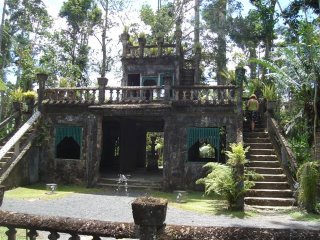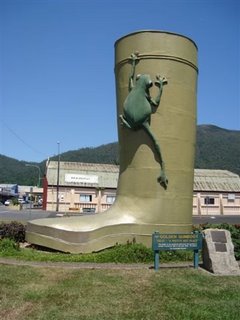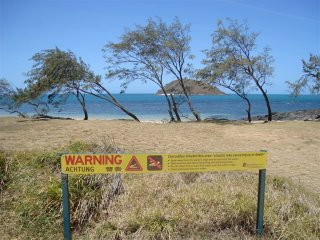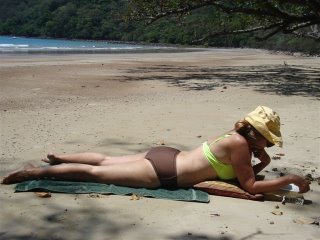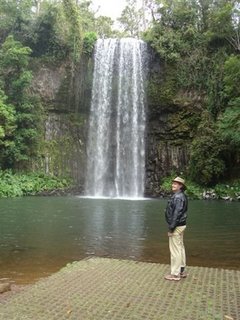Our first night was spent alongside the dry bed of the Campaspe River, sandwiched between the railway bridge and the road bridge in a well shaded spot with plenty of bird life flitting between the riverine trees. A distant clinking struck a chord in Lea’s memory of a windmill and as evening came George took a walk up the river bed and found the old metal windmill dribbling water into a rusty tank, a good few leaks to supply water to some grateful birds and kangaroos.
509km covered on Tuesday! Not because we wanted to but simply because the miles and miles of scrub and grassland utilised as cattle stations that stretched out in all directions around us, afforded no decent rest area. Even in the little communities along the route we couldn’t bring ourselves to pay for a caravan park where the sun beat down mercilessly and looked little better than the rest areas. And so our mileage crept up … The long day’s travel was broken by the interest that began developing on our arrival in Hughenden, to find “Mutt” the life-sized replica of a Muttaburrasaurus standing on a street corner. We discovered that we were travelling across a vast prehistoric inland sea rich in marine fossils. Sculptures by local artists depicting an ammonite, a pterosaur and “Darby” the dinosaur caught our eyes with the ingenious use of scrap metal. We were also most taken by a windmill rotunda we found in the middle of a wide street. Queensland seems to like the use of the word “rotunda” as we’ve seen it often and take it to mean a round meeting place.
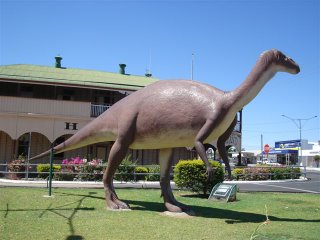
Mutt the Muttaburrasaurus in Hughenden
U Think They Saurus … was followed by a moments hesitation before it tickled our imaginations. This was the first of several signs about Kronosaurus Korner as we approached Richmond which proclaims to be the fossil capital of Australia. We decided we had to visit a place with such a quirky sense of humour. First we needed our lunch and the Lions Park fitted the bill with its green lawn and a place to park in the town centre. We noticed the edging of the lawn and a commemorative cairn had been made of strange round rocks. During our visit to Kronosaurus Korner we discovered these nodules are a unique feature to the Richmond Shire and are appropriately known as moon rocks. Richmond hosts a bi-annual moon rock throwing competition – shows how many of these moon shaped rocks are around. Cartoon-ish sounding Kronosaurus Korner turned out to be an exceptionally interesting and well presented marine fossil museum containing the remains of the Richmond pliosaur (the best preserved skeleton in the world), ichthyosaurs, the dinosaur (Minmi – preserved so well that even part of its stomach contents were intact) and Kronosaurus – the largest marine reptile to ever live, so huge, with teeth the size of bananas, that he could have eaten T. rex for breakfast.
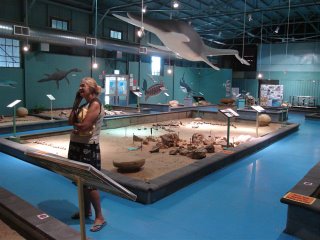
Kronosaurus Korner - marine fossil museum at Richmond
The worst section of the Overlander’s Way, best described as forgettable landscape, appeared to be over by the next day once we reached Cloncurry. Thereafter we meandered our way through the Selwyn Ranges with its dramatic rocky outcrops. One in particular looked like it was out of a cowboy movie with black kites circling above it in vulture fashion. Spinifex was back covering the foot slopes and, on a road that was decidedly better than yesterday, we made good time to Mt. Isa.
This statement appears in The Isa Visitor’s Guide welcome … “Mt Isa is one of the largest cities in the world, covering an area the size of Switzerland and with a main street 180km long!” We had to check this out as George could not credit it.
We took a ride around town as we wanted to see the underground hospital and the National Trust tent house, a style of house unique to Mt Isa in the early 1930’s, only to find all tourist attractions close at the end of September. Only mad dogs and ….. go out in this noonday sun! The “huge” city was done in next to no time and stopping at the Outback at Isa complex we established that the reason Mt Isa was once listed in the Guinness Book of Records as being the largest city with the longest main street is earned on a technicality. The Shire boundaries form the “city” and Camooweal, a “suburb” 180km away, falls under the jurisdiction of Mt Isa. Clearly, it’s nothing but a publicity ploy. An extra day was spent in Mt Isa in order for Skiv to have an oil change while Lea got our laundry done.
We were sweltering before we even pulled out of our caravan park for Camooweal on Friday. Casting an eye at our temperature gauge, reading 38°C so early in the day, we wondered where it would be by midday. Camooweal was nothing to shout about and with the thermometer steadily rising we wanted to put as much mileage as possible behind us. 13km further we crossed back into the Northern Territory to be surrounded by seas of sun-bleached yellow grass stretching to the horizon, a shimmering black road, edged in red soil that had been scraped clear of vegetation, lay endlessly before us. This was the Berkeley Tablelands, with warnings about cross winds and headwinds and no fuel for hundreds of kilometres. In the distance trees mirages danced and, under one scraggly shrub, cattle huddled together believing they were in shade. No windmills, no waterholes, dry creeks and river-beds, left us gulping down water and wondering how they survive. Through the heat haze we began to see grey columns rising and dissipating. These “cock-eyed bobs” (whirlwinds) became clearer as we passed through burnt out land and in one spot we had a heart-stopping moment when one engulfed us, sending us lurching sideways. We’d had enough of the western sun streaming directly into the cab and hot air blasting through the windows that when Berkeley Homestead offered shady, lawned sites we couldn’t resist this oasis. We flew out of Skiv into their swimming pool and wallowed for a good hour watching a truckie fastidiously polish all the chrome on his gigantic “mean machine”. Later a mud lark hopped into the caravan and checked out the floor as we sat mesmerised by our little guest. The sound of the Homestead’s generator beating away rhythmically and the warm air clinging to us, we felt as if we could have been in Beit Bridge as we tried to sleep.
More of the same next day as we as we completed the Overlander’s Way passing through huge tracts of sunburnt land. The heat drained us of conversation. At one time Lea leant back and said she had to think of England in a desperate effort to ‘feel’ cool when, lo and behold, against the expanse of blue sky appeared a streak of vapour trail, very much like the criss-crossed jet streams of NE Lincolnshire skies. Turning south on joining the Stuart Highway our hearts sank at the sight of another substantial distance to be covered across Central Australia in these high temperatures. We re-fueled in Tennant Creek and made haste for Devil’s Marbles Conservation Reserve where we thought we’d spend the night. Running parallel to the Stuart Highway the telephone line prompted George to babble on about the epic construction of the original overland telegraph line. Completed in 1872 it ended Australia’s communication isolation from the rest of the world when a single strand of wire was strung across the country from Darwin to Port Augusta. The 3200 km long line, built through the most inhospitable terrain with the aid of camels bringing in the poles – no less than 20 for every mile - connected Australia to a submarine cable from England. Lea retorted “so much for communication in 2007 when our mobiles are operational over only 12% of the country”. Just as well we arrived at the Devil’s Marbles and were distracted by the huge rounded boulders. Aboriginal dreamtime legend describes them as eggs of the Rainbow Serpent. Geo-morphologists use the term “cheeserings” because they resemble flattish lumps of cheese. The name Devil’s Marbles appears to date back to a description of the place when laying the telegraph line back in 1871. Lea thought The Cheese Factory would be just as suitable.
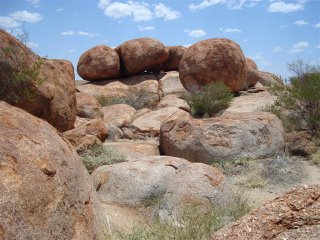
Rounded granite boulders - Devil's Marbles
With barely any shade in the campsite and the reflected heat off the granite, by the time we had finished our lunch we knew we’d been there long enough!
Next place on the map was Wycliffe Well, supposedly the UFO capital of Australia. Hitch-hiker Ed had told us about this place so our interest was piqued. We were startled to find a “Big Four” here, more so that this upmarket caravan park could have derelict cars, litter and beer cans strewn everywhere on its border. We could only believe a UFO had created this havoc! We passed on this overnight accommodation too.
Approaching Barrow Creek – our imaginations and curiosity came into play as this was the site of Peter Falconio’s murder and Joanne Lees’s escape that generated an intense man hunt in July 2001 with enormous media attention worldwide. During long hours on the road we have chewed over this case time and again with Paul, Saxon and Paula, as each of us completed reading Richard Shear’s book “Bloodstain – the vanishing of Peter Falconio”. Just as well it was a dark night as the bush where Joanne hid is very scanty and what she must have thought when her truckie rescuers took her to the Barrow Creek Hotel heaven knows as we were shocked by this seedy place. In comparison to the well kept historic Telegraph Repeater Station there, the hotel looked ram-shackled and down-at- the-heels, its “caravan park” awful.
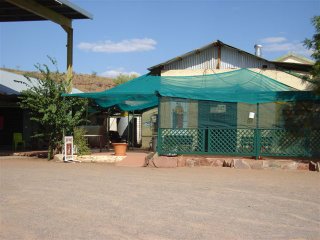
Barrow Creek Hotel (Joanne Lees brought here by truckies)
Eventually clocking up 560km to our day, we came to roost up for the night in Prowse Gap rest area. Got the generator going and caught up on our blog with mighty “King of the Roads” thundering past, all lit up like Christmas trees.
Soon after hitting the road on Sunday morning we came to the turn off to Aileron with its queer sign BIG MAN WALKING. We turned in to see what it was about and immediately spotted the statue of the big man standing proud on top of the hill. There was nothing around to explain its origins or that of the enclosures outside the pub with a dingo, an emu and a young camel within. Following the short loop road back to the Stuart Highway the surrounds of a “sociable” tree caught our eye with its broken bottles and beer cans blighting the landscape. In fact, much of the wide roadsides of the Stuart Highway, from Tennant Creek to Alice, glittered with wine sacks, aluminium cans, glass and plastic bottles along with beer cartons, plastic bags, car tyres and a higher than normal amount of discarded (stolen?) vehicles. Ironically, the entrances to communities were thick with beer cans despite large signs warning of liquor prohibition beyond that point. Not only does it show appalling disregard for hiding the evidence but it is also a dreadful indictment of the degradation of self and country.
After the long, flat route with little relief in the form of high ground the sense of arrival in Alice Springs was heightened by its rocky, broken terrain that took us into the city. We booked into a very central caravan park, turned on the air conditioning and recovered from our journey, pleased to have arrived in the centre of Australia!
